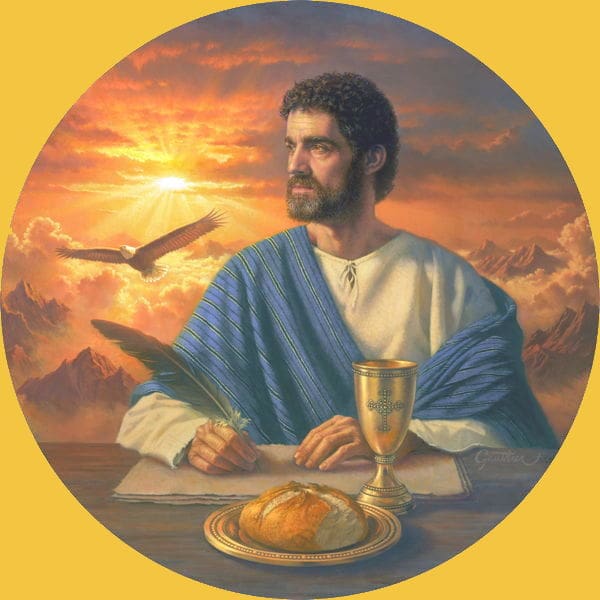Saint John the Evangelist

Today, the Church celebrates the Feast of Saint John the Evangelist. It is St. John who is thought to be the “Beloved Disciple”, the Apostle who is referred to as the one “whom Jesus loved” six times in the Gospel of St. John (John 13:23, 19:26, 20:2, 21:7, 21:20, 21:24). He is the only one of the Twelve who was understood not to have been martyred and, thus, lived to old age. That’s why the liturgical color for today is white, not red, which it is for all the other Apostles.
One of the sons of Zebedee or “Sons of Thunder”, who were originally fishermen, he was the brother of James the Greater. John was the only one of the Apostles to remain with Jesus while he hung on the Cross. He was entrusted to the Blessed Mother by the Lord … and She was also entrusted to John. He wrote five books of the New Testament: the Gospel of John, the first, second and third letters of John, and the book of Revelation, known previously as the Apocalypse.
The Gospel of Saint John the Evangelist is very different from the Gospels of Matthew, Mark, and Luke, also known as the Synoptics. It has more of a mystical bent to it, a very well-developed theology that is conveyed through the symbolism it employs, beginning, famously, with “In the beginning was the Word”, which we heard in the Gospel reading for the daytime Mass of Christmas Day … and which prologue was always read at the end of the Tridentine Mass.
Traditionally, Saint John’s Gospel is believed to have been written in Ephesus (an ancient Greek city now part of Turkey), where the Blessed Virgin Mary, who was entrusted to St. John, is said to have lived her last days on this earth. Eusebius’ 4th century “Church History” records a letter by the 2nd century Bishop Polycrates of Ephesus who identified Saint John as the one who reclined on the bosom of the Lord, wore “the sacerdotal plate” of a priest and died at Ephesus, thus singling him out as the Beloved Disciple. As well, St. Augustine, in his Tractate 119 (on John 19:24-30), also believed John to be the one whom Jesus loved. It has often been said that John was exiled to the island of Patmos in Greece during the Christian persecution, although this is disputed among scholars even though John himself says that he “found [himself] on … Patmos because [he] proclaimed God’s word and gave testimony to Jesus” (cf Revelation 1:9). But, no matter who one sides with, it places him in the Greek environs of the day.
In the painting by Corbert Gauthier, above, Saint John the Evangelist is depicted with an eagle, his traditional symbol, and one of the creatures referred to in Ezekiel 1:10 and in Revelation 4:7, which have often been taken to denote the authors of the Gospels. Being pictured with the chalice and bread is symbolic of the Eucharist and the Last Supper, where Saint John the Apostle leaned his head on Jesus’ chest (cf John 13:23).
The Apostle Saint John the Evangelist is, and has been, a great gift to the Church. Let us implore his prayers!
+
Art for this post on Saint John the Evangelist: St. John the Evangelist (shown with his traditional symbol; at St. Anthony’s Catholic Church, Steinauer, Nebraska, USA), Corbert Gauthier, 2013, copyright, all rights reserved, used with permission.





